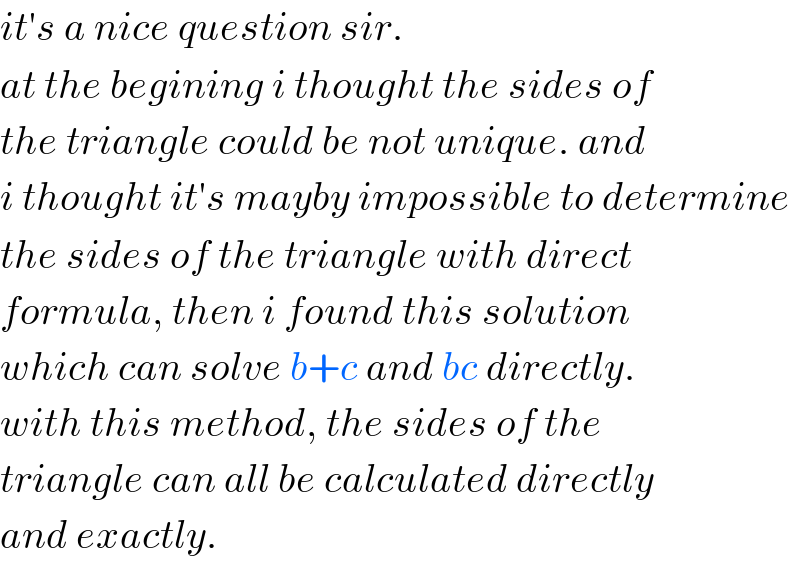
Question and Answers Forum
Question Number 52539 by ajfour last updated on 09/Jan/19

Answered by mr W last updated on 09/Jan/19
![p=((√([(b+c)^2 −a^2 ][a^2 −(b−c)^2 ]))/(2a)) r=((√([(b+c)^2 −a^2 ]bc))/(b+c)) m=((√(2(b^2 +c^2 )−a^2 ))/2) ⇒a^2 =2(b^2 +c^2 )−4m^2 ...(iii) ⇒(r^2 −bc)(b+c)^2 =2bc[2m^2 +2bc−(b+c)^2 ] ⇒8p^2 [(b+c)^2 −2m^2 −2bc)=[4m^2 +4bc−(b+c)^2 ][(b+c)^2 −4m^2 ] let X=b+c, Y=bc ⇒(r^2 −Y)X^2 =2Y(2m^2 +2Y−X^2 ) ...(i) ⇒8p^2 (X^2 −2Y−2m^2 )=(4m^2 +4Y−X^2 )(X^2 −4m^2 ) ...(ii) from (i): ⇒X^2 =((4Y(m^2 +Y))/(r^2 +Y)) ⇒p^2 [((2Y(m^2 +Y))/(r^2 +Y))−Y−m^2 ]=[m^2 +Y−((Y(m^2 +Y))/(r^2 +Y))][((Y(m^2 +Y))/(r^2 +Y))−m^2 ] ⇒Y=r^2 (√((m^2 −p^2 )/(r^2 −p^2 ))) ...(1) ⇒X=2(√((Y(m^2 +Y))/(r^2 +Y))) ...(2) with p=(√(15)), m=(√(31)), r=2(√6) ⇒Y=24(√((31−15)/(24−15)))=24×(4/3)=32(=bc) ⇒X=2(√((32(31+32))/(24+32)))=12(=b+c) ⇒b and c are roots of z^2 −12z+32=0 (z−8)(z−4)=0 ⇒b=8, c=4 (or b=4, c=8) from (iii): ⇒a=6](Q52568.png)
Commented by ajfour last updated on 10/Jan/19

Commented by mr W last updated on 10/Jan/19

Commented by mr W last updated on 13/Jan/19

Answered by behi83417@gmail.com last updated on 09/Jan/19
![4m^2 =2(b^2 +c^2 )−a^2 =124(i) ⇒b^2 +c^2 =62+(a^2 /2) r=((2bc)/(b+c))cos(A/2)=((2bc)/(b+c))(√((p(p−a))/(bc))) (2/(b+c))(√(bcp(p−a)))=2(√6)⇒bcp(p−a)=6(b+c)^2 (ii) bc(((a+b+c)/2))(((b+c−a)/2))=6(b+c)^2 ⇒ bc[(b+c)^2 −a^2 ]=24(b+c)^2 bc[62+(a^2 /2)+2bc−a^2 ]=24(b+c)^2 =24(62+(a^2 /2)+2bc) ⇒bc(62+2bc−(a^2 /2))=24(62+(a^2 /2)+2bc) 62bc+2(bc)^2 −bc.(a^2 /2)=24(62+(a^2 /2)+2bc) ⇒(bc)^2 +(7−(a^2 /4)).bc−6a^2 −744=0 .....](Q52569.png)
